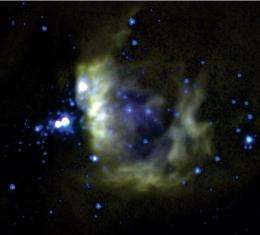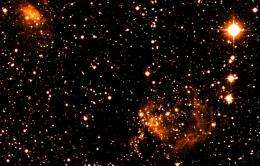CSIRO telescope spots mega-star cradle

(PhysOrg.com) -- Using a CSIRO radio telescope, an international team of researchers has caught an enormous cloud of cosmic gas and dust in the process of collapsing in on itself -- a discovery which could help solve one of astronomy's enduring conundrums: "How do massive stars form?"
Dr Peter Barnes from the University of Florida says astronomers have a good grasp of how stars such as our Sun form from clouds of gas and dust, but for heavier stars - ten times the mass of the Sun or more - they are still largely in the dark, despite years of work.
“Astronomers are still debating the physical processes that can generate these big stars,” Dr Barnes says.
“Massive stars are rare, making up only a few per cent of all stars, and they will only form in significant numbers when really massive clouds of gas collapse, creating hundreds of stars of different masses. Smaller gas clouds are not likely to make big stars.”
Accordingly, regions in space where massive stars seem to be forming are also rare. Most are well over 1000 light-years away, making them hard to observe.
Using CSIRO’s ‘Mopra’ radio telescope - a 22m dish near Coonabarabran, NSW - the research team discovered a massive cloud of mostly hydrogen gas and dust, three or more light-years across, that is collapsing in on itself and will probably form a huge cluster of stars.
Dr Stuart Ryder of the Anglo-Australian Observatory said the discovery was made during a survey of more than 200 gas clouds.
“With clouds like this we can test theories of massive star cluster formation in great detail.”
The gas cloud, called BYF73, is about 8,000 light years away, in the constellation of Carina (“the keel”) in the Southern sky.
Evidence for ‘infalling’ gas came from the radio telescope’s detection of two kinds of molecules in the cloud - HCO+ and H13CO+. The spectral lines from the HCO+ molecules in particular showed the gas had a velocity and temperature pattern that indicated collapse.
Mopra Research Scientist at CSIRO Astronomy and Space Science, Dr Kate Brooks, said the Mopra telescope excels at giving a picture of the complex chemistry of cosmic gas clouds.
“Much of its time is used for large projects like this, and almost all Mopra projects are international collaborations.”

The CSIRO telescope observations were confirmed by observations with the Atacama Submillimeter Telescope Experiment (ATSE) telescope in Chile.
The research team calculates that the gas is falling in at the rate of about three per cent of the Sun’s mass every year - one of the highest rates known.
Follow-up infrared observations made with the 3.9-m Anglo-Australian Telescope (also near Coonabarabran, NSW) showed signs of massive young stars that have already formed right at the centre of the gas clump, and new stars forming.
Star-formation in the cloud was also evident in archival data from the Spitzer and MSX spacecraft, which observe in the mid-infrared.
Gas cloud BYF73 was found during a large-scale search for massive star-forming regions - the Census of High- and Medium-mass Protostars, or CHaMP. This is one of the largest, most uniform and least biased surveys to date of massive star-forming regions in our Galaxy.
The research team’s findings have been published in the Monthly Notices of the Royal Astronomical Society, 402, 73-86 (2010).
Provided by CSIRO



















